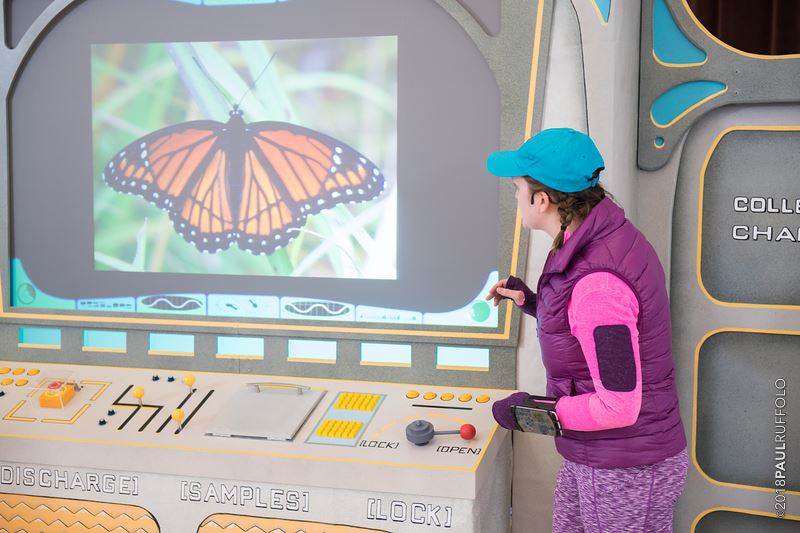 Exploring New Worlds:
Exploring New Worlds:
Using Technology to Expand Imagination
By Dave McLellan
Museum theater professionals get the most interesting of requests and our Kohl’s Wild Theater program from the Zoological Society of Milwaukee is no exception. In 2013, we were asked to develop a STEM-based theatrical program for middle school audiences that would feature our zoo’s fieldwork in the Democratic Republic of the Congo. In 2016, we were asked to make a show about the solar system; a strange request when you consider that we are a very earth-oriented institution. But, being the museum creative types that we are, we didn’t shy away from these challenges. In fact, these two projects had a lot in common because they used audio-visual technologies to enhance storytelling in ways that would otherwise be impossible.
Before I jump into the technological journeys, I need to state clearly that technological gizmos are not required for great storytelling. In fact, I almost always prefer the creative use of simple objects to encourage active participation and imagination from the audience. But sometimes imagination might not be enough, or even worse, could do a disservice to the message you are trying to share. My best example is the show about fieldwork in the Congo – The Congo Code. Our institution is a leader in bonobo conservation and does extraordinary work to study and protect the species in their natural habitat. The reality is that bonobos are the rarest of the great apes due to intense poaching. Letting young audiences imagine the risks associated with that part of the world could result in legitimate fear or concern that would disengage the audience. How do you teach about life-threatening violence in an age-appropriate way?
 Our creative hook was gaming. We researched stories such as Jumanji and The Hunger Games. We learned about the use of video games in traditional education. We considered violence in video games and what would be age appropriate for a middle school audience. As an artistic team, it was decided early on that a video game would provide the best world to safely navigate the real-life threat of poaching that our conservationists experience in the field. To achieve this effect, we knew that we couldn’t rely on simple props alone. Instead, we created a 7-foot screen with a rear projector that served as the majority of the set. The audience’s imaginations were still in charge as we led them to believe that we were in a gaming space. We still used simple objects such as pixilated icons that were operated by puppeteers. In fact, the bonobo in the story was portrayed by two puppeteers with pixilated costumes to represent their involvement in the game. But the inclusion of technology gave us control of the world. We used live cameras to differentiate between real-life and the game. One character of the show was grounded in the real world and projected into the video game screen. Others were live actors playing characters as functions of the game. Using cameras, projections, and sound to express the world of the play made a complicated subject accessible. At the end of the show, we led a talk-back with the audience that included the real video footage of our conservation teams in the Democratic Republic of the Congo. Audiences could see the real-life version of the game on stage, a presentation that would be otherwise impossible without investment in technology.
Our creative hook was gaming. We researched stories such as Jumanji and The Hunger Games. We learned about the use of video games in traditional education. We considered violence in video games and what would be age appropriate for a middle school audience. As an artistic team, it was decided early on that a video game would provide the best world to safely navigate the real-life threat of poaching that our conservationists experience in the field. To achieve this effect, we knew that we couldn’t rely on simple props alone. Instead, we created a 7-foot screen with a rear projector that served as the majority of the set. The audience’s imaginations were still in charge as we led them to believe that we were in a gaming space. We still used simple objects such as pixilated icons that were operated by puppeteers. In fact, the bonobo in the story was portrayed by two puppeteers with pixilated costumes to represent their involvement in the game. But the inclusion of technology gave us control of the world. We used live cameras to differentiate between real-life and the game. One character of the show was grounded in the real world and projected into the video game screen. Others were live actors playing characters as functions of the game. Using cameras, projections, and sound to express the world of the play made a complicated subject accessible. At the end of the show, we led a talk-back with the audience that included the real video footage of our conservation teams in the Democratic Republic of the Congo. Audiences could see the real-life version of the game on stage, a presentation that would be otherwise impossible without investment in technology.
Flash forward a few years to our challenge of going into space. The first question to answer was how to tie space curriculum to our institutional mission of conservation. The solution was to examine Earth’s unique capacity to support life in comparison to the other planets. After a few failed script drafts, we realized that we needed to travel to all of the planets. Otherwise, we would only talk about space which would get very boring very fast. To solve this problem, we drew upon the technologies we developed from producing The Congo Code. The key elements were a rear projector and a live camera. But this time, it wasn’t an all-inclusive screen defining the world of the play. In this new show, the projections served as a large computer monitor on the control deck of an imaginary spaceship. With the use of projections, we could show images of what the spaceship was passing. We could pull up images of Earth and animals featured in the show. We even made the computer into a character that could interact with the actors on stage. The result was our show, The Monarch: A Space Adventure. With the use of simple technologies, we could expand the imaginary journey to experiences that would otherwise seem juvenile.
 The technologies we employed in 2014 and 2018 were the same, but the way we managed those assets changed greatly between the two shows. First and foremost, we learned that to successfully use this technology, you need staff support to manage it. The more gadgets and gizmos you add, the more possibility that something could go wrong. If you only have your acting team on hand to resolve the issues, the entire experience can be disrupted. We now operate all of our shows with a stage manager who is trained to troubleshoot malfunctions during a performance. Secondarily, you need a partner that has a great understanding of the technology and the ability to adapt it to your needs. Museum Theater, by its nature, has to be adaptable to non-traditional spaces. To make technology work in that regard, there needs to be a developmental process to work out bugs. Many of our technological accomplishments have been possible through a collaboration with Chris Guse, a professor at the University of Wisconsin-Milwaukee, who specializes in audio-visual technologies in theater. We have been able to utilize Chris’s expertise in development, implementation, and post-launch to deal with technical issues at every phase.
The technologies we employed in 2014 and 2018 were the same, but the way we managed those assets changed greatly between the two shows. First and foremost, we learned that to successfully use this technology, you need staff support to manage it. The more gadgets and gizmos you add, the more possibility that something could go wrong. If you only have your acting team on hand to resolve the issues, the entire experience can be disrupted. We now operate all of our shows with a stage manager who is trained to troubleshoot malfunctions during a performance. Secondarily, you need a partner that has a great understanding of the technology and the ability to adapt it to your needs. Museum Theater, by its nature, has to be adaptable to non-traditional spaces. To make technology work in that regard, there needs to be a developmental process to work out bugs. Many of our technological accomplishments have been possible through a collaboration with Chris Guse, a professor at the University of Wisconsin-Milwaukee, who specializes in audio-visual technologies in theater. We have been able to utilize Chris’s expertise in development, implementation, and post-launch to deal with technical issues at every phase.
At the end of the day, the goal is to tell a compelling story that delivers a clear message to the audience about your institution’s mission. If used correctly and with specific intent, technology can bolster Museum Theater’s potential. For us, technology opened opportunities to dive into surreal worlds of our imagination and launch us into outer space. But if we didn’t have the support mechanisms to adapt and maintain the technology, the entire operation could be derailed and would defeat the point of doing theater in the first place. With the right mix of imagination, creativity, and technical expertise – anything is possible. 
This article can be found in Spring 2018 - "The Future is Now: Tech in Museum Theatre" (Volume 28, Issue 2) of IMTAL Insights.

ABOUT THE AUTHOR:

Dave McLellan currently directs Kohl’s Wild Theater, a program from the Zoological Society of Milwaukee in partnership with Kohl’s Cares. Since 2011, Kohl’s Wild Theater has produced over 22 original plays and musicals to be performed at the Milwaukee County Zoo and on tour throughout Southeast Wisconsin. In June of 2018, Dave will transition to become the Director of Guest Experience for the EarlyWorks Family of Museums in Huntsville, AL.